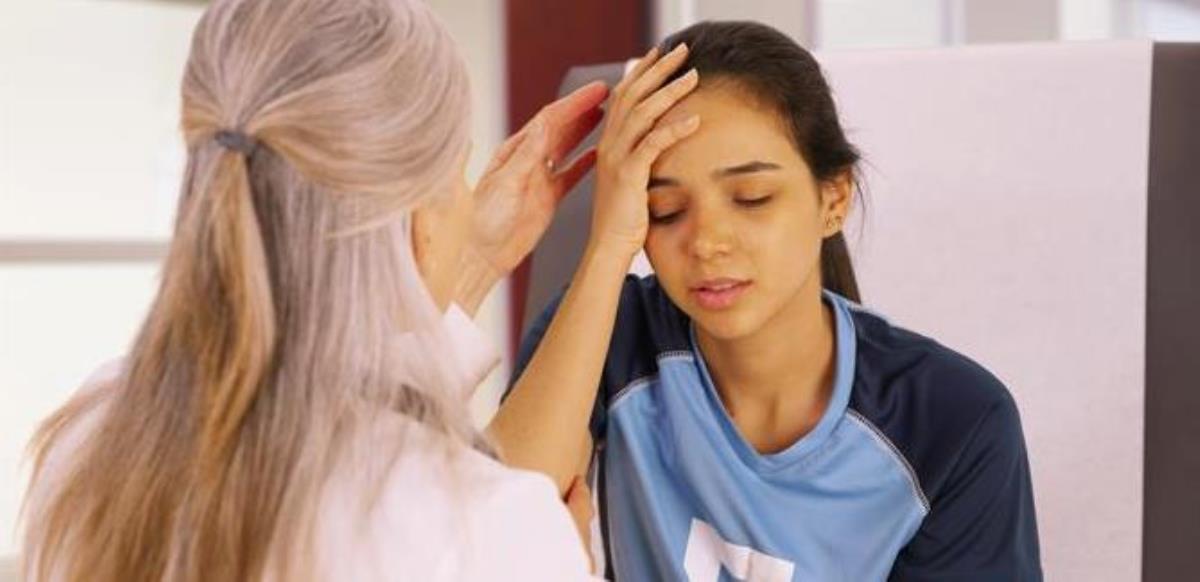Experts discuss rare link between concussion, suicide

The most recent CDC data show an estimated 329,290 children were treated in United States for sports and recreation-related injuries that included a diagnosis of concussion or traumatic brain injury.
For most children, the symptoms of concussion - headaches, nausea, balance problems or dizziness, vision problems, noise or light sensitivity, and concentration or memory problems will be limited to a few weeks and usually dissipate within a month when treated properly, according to the Concussion Legacy Foundation. Some patients will experience post-concussion syndrome, where these signs endure for 2 months or more.
In rare instances, concussions can lead to suicide. A review in the Canadian Medical Association Journal found a low overall rate of suicide in 235,110 patients with concussion, but that this rate was still three times the normal rate of suicide.
Although research is limited, there is some evidence that personal or family history of depression or mental illness prior to a concussion may increase the risk of suicide. A history of repeated traumatic brain injuries also may be a risk factor.
High-profile cases, such as NFL Hall of Famer Junior Seau, who committed suicide after a career that included multiple significant blows to the head, or Olympic cyclist Kelly Catlin, whose family said she committed suicide and also referenced a concussion that led to her having severe headaches and sensitivity to light, may lead patients or family members to fear a increased for suicide after a concussion or TBI. Clinicians should acknowledge the concussion-suicide link but it should be a limited part of discussions with patients and families after head injuries.
“Concussions are important and warrant prompt, serious medical attention, but they are not automatically doomsday,” Christopher C. Giza, MD, director of the University of California at Los Angeles' Steve Tisch BrainSPORT program, told Healio Primary Care Today.

“Though we know there is a history of mental health problems and psychological issues and suicide with traumatic brain injury, those usually occur in the moderate and severe head injuries that involve bleeding, bruising and damage to the frontal lobes that control mood and executive function. Most patients with concussion never reach this level, recover fully, and many go on to resume physical activity,” he continued. “Limit the time you spend discussing the link.”
Giza also stressed that the concussion-suicide link should be discussed with patients in a way that educates, not alarms.
He provided some clinical pearls on doing so: emphasizing the link is the exception, not the rule; addressing concussion symptoms and screening for mental conditions and authorize interventions as appropriate.
“Perhaps most importantly, do not focus on the concussion-related pain for too long and do not suggest the patient may fall athletically or academically behind their peers,” Giza said.

Even those who have discussed the concussion-suicide link with their primary care physicians will not always be forthright that they are suffering from depression or are contemplating suicide, Kevin E. Crutchfield, MD, director of the Comprehensive Sports Concussion Program at LifeBridge Health in Baltimore, warned.
“Patients rarely come in saying they feel depressed or that they want to take their own life. You must screen every patient that comes in to clinic with a reported, suspected or confirmed concussion with the PHQ-9, even those patients you have seen before and tested fine,” he told Healio Primary Care Today.

Joan R. Asarnow, PhD, ABPP, director of the Youth Stress & Mood Program at the University of California at Los Angeles said the Columbia Suicide Severity Rating Scale or Ask Suicide Screening Questions toolkit can also be used to assess suicide risk in pediatric patients who have been concussed.
“For patients who screen positive on a screening measure, you can connect them to a psychologist or psychiatrist for further evaluation, or seek consultation regarding optimal next steps given your patient’s presentation. Often times, initial screens are supplemented by 'therapeutic assessments of imminent behavioral risk.' These therapeutic assessments can provide both safety planning and other therapeutic interventions while also providing further evaluation of behaviors that are incompatible with suicide such as whether youths have reasons for living and safe strategies that they can use to respond to stress in a non-suicidal manner and whether parents feel able to protect the youth and restrict access to potentially deadly methods of suicide,” she said.
The signs and risk factors for suicidality are similar for patients who have been concussed and those who are not: feeling hopeless about a situation; escalating or heavy use of alcohol or drugs; changing sleeping or eating habits; engaging in risky behaviors; saying permanent goodbyes to loved ones; developing personality changes; talking about suicide; obtaining the means to commit suicide; giving away personal belongings; distancing themselves from social contact; having mood swings and/or preoccupying themselves with death, dying or violence.
Though tests and signs that warn of suicide ideation have been validated and are used extensively by the medical community, they still may not work on every patient, Giza warned.
“Predicting suicide is not an exact science. The biggest risk factor for suicide is a person making a prior attempt or self-harm behavior and/or a previously diagnosed mental health problem,” he said.
The impact that causes a concussion and the thought of suicide are not simultaneous, periodic screenings for suicide in the weeks and months following a concussion should also occur.
This necessitates PCPs involve others in the patient’s recovery, a researcher told Healio Primary Care Today.
“The social and professional structures surrounding these athletes — friends, family, coaches, athletic trainers, team physicians — need to be made aware of the increased risk for depression in patients with concussion and help the athletes monitor for symptoms so that appropriate treatment can be sought if warranted,” Mark DeBeliso, PhD, ACSM, director of Southern Utah University’s Master of Science in Sports Conditioning and Performance said in an interview.
Tahira Wangnoo, BS, MPH, then an epidemiology intern at the Georgia State University School of Public Health and colleagues identified additional ways outside the ED or examination room that patients with concussion contemplating or attempting suicide can he helped.
In addition, an analysis appearing in Pediatrics reported that most children who suffer sports- and recreation-related concussions in U.S. children are not seen in health care settings. This requires increasing awareness of the potential for concussions and the importance of obtaining medical care for patients suspected of having had a head injury.

“Concussion prevention education efforts in high schools are warranted. In addition, it’s imperative to educate parents, teachers, and health professionals how to recognize a concussion and any possible mental health outcomes as a result,” they wrote in the Journal of Neurotrauma.
Crutchfield said for most patients, most of the steps outlined in this story will never be needed. But in the rare instances that a patient screens positive for depression, the patient should immediately be referred to a psychiatrist or other behavioral health specialist for immediate treatment such as counseling and/or pharmacology.

Michael Fralick, MD, SM, the lead author of the Canadian Medical Association Journal review agreed, adding PCPs and those closest to the patient play a pivotal role in preventing an increasingly common head injury from turning into an even worse tragedy.
“PCPs and others that are in the patient’s inner circle must do what they can to identify patients at risk for suicide and then do their best to mitigate that risk,” he said.
PCPs who still have questions regarding preventing, diagnosing and treating concussions can review the CDC, and AAP guidelines. Both entities have revised their existing guidelines in the past year regarding these head injuries. – by Janel Miller
References:
AAP. Pediatrics. 2018;doi:10.1542/peds.2018-3074.
Bryan MA, et al. Pediatrics. 2016;doi:10.1542/peds.2015-4635.
CDC.gov. “Traumatic brain injury & concussions. Outcomes”
https://www.cdc.gov/traumaticbraininjury/outcomes.html. Accessed March 20, 2019.
CDC. "Traumatic brain injury & concussions. Get the facts." https://www.cdc.gov/traumaticbraininjury/get_the_facts.html. Accessed March 21, 2019.
Cleveland Clinic. “Concussions.” https://my.clevelandclinic.org/health/diseases/15038-concussions. Accessed Jan. 17, 2019.
Concussion Legacy Foundation. “What is PCS?” https://concussionfoundation.org/PCS-resources/what-is-PCS. Accessed March 22, 2019.
Cooper-Patrick L, et al. JAMA. 1994 Dec 14;272(22):1757-62.
Fralick M, et al. JAMA Neurol. 2018;doi:10.1001/jamaneurol.2018.3487.
Fralick M, et al. CMAJ. 2016;doi:10. 10.1503/cmaj.150790.
Isometsa ET, et al. Am J Psychiatry. 1994 Apr;151(4):530-6.
Kerr ZY, et al. Inj Epidemiol.2014;doi:10.1186/s40621-014-0028-x.
Los Angeles Times. “Junior Seau had brain disease when he committed suicide.” http://articles.latimes.com/2013/jan/10/sports/la-sp-sn-junior-seau-brain-20130110.
Mayo Clinic. "Suicide and suicidal thoughts." https://www.mayoclinic.org/diseases-conditions/suicide/symptoms-causes/syc-20378048. Accessed Jan. 17, 2019.
Mez J, et al. JAMA. 2017;doi:10.1001/jama.2017.8334.Miital V, et al. Psychiatr Serv 2009;doi:10.1176/ps.2009.60.3.384
Pittsburgh Post-Gazette. “U.S. Olympic cycling medalist Kelly Catlin has died by suicide at 23, her family says.” https://www.post-gazette.com/news/obituaries/2019/03/10/Kelly-Catlin-US-Olympic-cyclist-died-23-silver-medal-pursuit-team-2016/stories/201903100231. Accessed March 22, 2019.
Pryor J, et al. J Lifestyle Med. 2018;doi:10.15280/jlm.2016.6.1.7.
Wallace J, et al. J Athl Train. 2017;doi:10.4085/1062-6050.52.1.07.
Shura RD, et al. Psychol Serv. 2018;doi:10.1037/ser0000208.
University of Pittsburgh. "Neurological Surgery." http://www.neurosurgery.pitt.edu/centers-excellence/brain-and-spine-injury/concussions. Accessed March 21, 2019.
Wangnoo T, et al. J Neurotrauma. 2018;doi:10.1089/neu.2018.5721.
Disclosures: Asarnow directs a Substance Abuse and Mental Health Services Administration center for trauma-informed suicide, self-harm, and substance abuse prevention & treatment; Crutchfield is a neurologist for the Baltimore Ravens, a member of the NFL committee TBI committee, a member of the American Physiological Society, on the American Society of Neuroimaging board of directors, on the Health and Safety Committee of the Maryland State Secondary School Athletic Association, the Government Oversight Committee for the Traumatic Brain Injury Endpoint Development Trial for the Department of Defense and the Baltimore County Athletics Concussion Committee; Fralick reports no relevant financial disclosures; Giza directs the NFL Neurological Care Program at the University of California at Los Angeles, receives grant/research support from the NCAA, U.S. Department of Defense, University of California Steve Tisch BrainSPORT program, NIH NINDS (R01 NS27544), NINDS Neural Analytics SBIR grant (NS092209 2016-2018), UCLA Brain Injury Research Center, Easton Clinic for Brain Health, is a consultant to the NBA, NHLPA, on the advisory panel for Highmark Interactive, MLS, NBA, US Soccer Federation, NCAA Concussion Committee, a past shareholder in Highmark Interactive stock options and receiving book royalties for “Prioritized neurological differential diagnosis."
